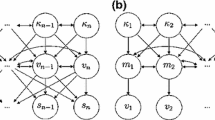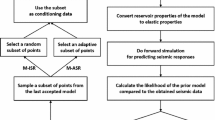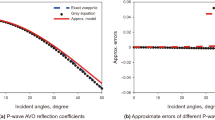Abstract
We infer the elastic and petrophysical properties from pre-stack seismic data through a transdimensional Bayesian inversion. In this approach the number of model parameters (i.e. the number of layers) is treated as an unknown, and a reversible jump Markov Chain Monte Carlo (rjMCMC) algorithm is used to sample the variable-dimension model space. This inversion scheme provides a parsimonious solution, and reliably quantifies the uncertainties affecting the estimated model parameters. Parallel tempering, which employs a sequence of interacting Markov chains in which the likelihood function is successively relaxed, is used to improve the efficiency of the probabilistic sampling. In addition, the delayed rejection updating scheme is employed to speed up the convergence of the rjMCMC algorithm to the stationary regime. Both elastic and petrophysical inversions invert the amplitude versus angle responses and employ a convolutional forward modelling based on the exact Zoeppritz equations. First, synthetic tests are used to assess the reliability of the implemented rjMCMC algorithms, then their applicability is demonstrated by inverting field seismic data acquired onshore. In this case the inversion was aimed at inferring the elastic and petrophysical properties around a gas-saturated reservoir hosted in a shale-sand sequence. In this case, the final outcomes provided by the rjMCMC algorithms are also compared with the predictions of linear Bayesian elastic and petrophysical inversions. The synthetic and field data examples demonstrate that the implemented algorithms can successfully estimate model uncertainty, model dimensionality and subsurface parameters with an affordable computational cost.


















Similar content being viewed by others
References
Agostinetti, N. P., & Malinverno, A. (2010). Receiver function inversion by trans-dimensional Monte Carlo sampling. Geophysical Journal International,181(2), 858–872.
Aki, K., & Richards, P. G. (1980). Quantative seismology: Theory and methods. New York.
Al-Awadhi, F., Hurn, M., & Jennison, C. (2004). Improving the acceptance rate of reversible jump MCMC proposals. Statistics & Probability Letters,69(2), 189–198.
Aleardi, M. (2018). Estimating petrophysical reservoir properties through extended elastic impedance inversion: applications to off-shore and on-shore reflection seismic data. Journal of Geophysics and Engineering,15(5), 2079–2090.
Aleardi, M., & Ciabarri, F. (2017). Assessment of different approaches to rock-physics modeling: A case study from offshore Nile Delta. Geophysics, 82(1), MR15–MR25.
Aleardi, M., Ciabarri, F., & Gukov, T. (2018a). A two-step inversion approach for seismic-reservoir characterization and a comparison with a single-loop Markov-chain Monte Carlo algorithm. Geophysics,83(3), R227–R244.
Aleardi, M., Ciabarri, F., & Gukov, T. (2018b). Reservoir characterization through target-oriented AVA-petrophysical inversions with spatial constraints. Pure and Applied Geophysics,176(2), 901–924.
Ando, T. (2010). Bayesian model selection and statistical modeling. Boca Raton: Chapman and Hall/CRC.
Aster, R. C., Borchers, B., & Thurber, C. H. (2018). Parameter estimation and inverse problems. Amsterdam: Elsevier.
Avseth, P., Mukerji, T., & Mavko, G. (2010). Quantitative seismic interpretation: Applying rock physics tools to reduce interpretation risk. Cambridge: Cambridge University Press.
Bianco, E. (2016). Tutorial: Wavelet estimation for well ties. The Leading Edge,35(6), 541–543.
Bodin, T., & Sambridge, M. (2009). Seismic tomography with the reversible jump algorithm. Geophysical Journal International,178(3), 1411–1436.
Bodin, T., Sambridge, M., Tkalčić, H., Arroucau, P., Gallagher, K., & Rawlinson, N. (2012). Transdimensional inversion of receiver functions and surface wave dispersion. Journal of Geophysical Research: Solid Earth,117, B02301.
Bosch, M., Cara, L., Rodrigues, J., Navarro, A., & Díaz, M. (2007). A Monte Carlo approach to the joint estimation of reservoir and elastic parameters from seismic amplitudes. Geophysics,72(6), O29–O39.
Brooks, S. P., Giudici, P., & Roberts, G. O. (2003a). Efficient construction of reversible jump Markov chain Monte Carlo proposal distributions. Journal of the Royal Statistical Society: Series B (Statistical Methodology),65(1), 3–39.
Brooks, S. P., Giudici, P., & Philippe, A. (2003b). Nonparametric convergence assessment for MCMC model selection. Journal of Computational and Graphical Statistics,12(1), 1–22.
Buland, A., & Omre, H. (2003). Bayesian linearized AVO inversion. Geophysics,68(1), 185–198.
Cho, Y., Gibson, R. L., Jr., & Zhu, D. (2018). Quasi 3D transdimensional Markov-chain Monte Carlo for seismic impedance inversion and uncertainty analysis. Interpretation,6(3), T613–T624.
Dadi, S., Gibson, R., & Wang, K. (2016). Velocity log upscaling based on reversible jump Markov chain Monte Carlo simulated annealing RJMCMC-based sonic log upscaling. Geophysics,81(5), R293–R305.
de Nicolao, A., Drufuca, G., & Rocca, F. (1993). Eigenvalues and eigenvectors of linearized elastic inversion. Geophysics,58(5), 670–679.
Dettmer, J., & Dosso, S. E. (2012). Trans-dimensional matched-field geoacoustic inversion with hierarchical error models and interacting Markov chains. The Journal of the Acoustical Society of America,132(4), 2239–2250.
Dosso, S. E., Holland, C. W., & Sambridge, M. (2012). Parallel tempering for strongly nonlinear geoacoustic inversion. The Journal of the Acoustical Society of America,132(5), 3030–3040.
Dosso, S. E., Dettmer, J., Steininger, G., & Holland, C. W. (2014). Efficient trans-dimensional Bayesian inversion for geoacoustic profile estimation. Inverse Problems,30(11), 114018.
Falcioni, M., & Deem, M. W. (1999). A biased Monte Carlo scheme for zeolite structure solution. The Journal of Chemical Physics,110(3), 1754–1766.
Galetti, E., & Curtis, A. (2018). Transdimensional electrical resistivity tomography. Journal of Geophysical Research: Solid Earth,123(8), 6347–6377.
Gelman, A., Stern, H. S., Carlin, J. B., Dunson, D. B., Vehtari, A., and Rubin, D. B. (2013). Bayesian data analysis. Boca Raton: Chapman and Hall/CRC.
Geyer, C. J., & Møller, J. (1994). Simulation procedures and likelihood inference for spatial point processes. Scandinavian Journal of Statistics, 21(4), 359–373.
Gilks, W. R., Richardson, S., & Spiegelhalter, D. (1995). Markov chain Monte Carlo in practice. Boca Raton: CRC Press.
Grana, D., & Della Rossa, E. (2010). Probabilistic petrophysical-properties estimation integrating statistical rock physics with seismic inversion. Geophysics,75(3), O21–O37.
Green, P. J. (1995). Reversible jump Markov chain Monte Carlo computation and Bayesian model determination. Biometrika,82, 711–732.
Green, P. J., & Mira, A. (2001). Delayed rejection in reversible jump Metropolis–Hastings. Biometrika,88(4), 1035–1053.
Haario, H., Saksman, E., & Tamminen, J. (1999). Adaptive proposal distribution for random walk Metropolis algorithm. Computational Statistics,14(3), 375–396.
Haario, H., Saksman, E., & Tamminen, J. (2001). An adaptive Metropolis algorithm. Bernoulli,7(2), 223–242.
Haario, H., Laine, M., Mira, A., & Saksman, E. (2006). DRAM: efficient adaptive MCMC. Statistics and Computing,16(4), 339–354.
Malinverno, A. (2000). A Bayesian criterion for simplicity in inverse problem parametrization. Geophysical Journal International,140(2), 267–285.
Malinverno, A. (2002). Parsimonious Bayesian Markov chain Monte Carlo inversion in a nonlinear geophysical problem. Geophysical Journal International,151(3), 675–688.
Malinverno, A., & Briggs, V. A. (2004). Expanded uncertainty quantification in inverse problems: Hierarchical Bayes and empirical Bayes. Geophysics,69(4), 1005–1016.
Mandolesi, E., Ogaya, X., Campanyà, J., & Agostinetti, N. P. (2018). A reversible-jump Markov chain Monte Carlo algorithm for 1D inversion of magnetotelluric data. Computers & Geosciences,113, 94–105.
Martin, G. S., Wiley, R., & Marfurt, K. J. (2006). Marmousi2: An elastic upgrade for Marmousi. The Leading Edge,25(2), 156–166.
Misra, S., & Sacchi, M. D. (2008). Global optimization with model-space preconditioning: Application to AVO inversion. Geophysics,73(5), R71–R82.
Mosegaard, K., & Sambridge, M. (2002). Monte Carlo analysis of inverse problems. Inverse problems,18(3), R29.
Passos de Figueiredo, L., Grana, D., Luis Bordignon, F., Santos, M., Roisenberg, M., & Rodrigues, B. B. (2018). Joint Bayesian inversion based on rock-physics prior modeling for the estimation of spatially correlated reservoir properties. Geophysics,83(5), 1–53.
Ray, A. K., & Chopra, S. (2016). Building more robust low-frequency models for seismic impedance inversion. First Break,34(5), 47–52.
Ray, A., Kaplan, S., Washbourne, J., & Albertin, U. (2017). Low frequency full waveform seismic inversion within a tree based Bayesian framework. Geophysical Journal International,212(1), 522–542.
Sajeva, A., Aleardi, M., & Mazzotti, A. (2017). Genetic algorithm full-waveform inversion: uncertainty estimation and validation of the results. Bollettino di Geofisica Teorica ed Applicata, 58(4), 395–414.
Sambridge, M. (2014). A parallel tempering algorithm for probabilistic sampling and multimodal optimization. Geophysical Journal International,196(1), 357–374.
Sambridge, M., & Mosegaard, K. (2002). Monte Carlo methods in geophysical inverse problems. Reviews of Geophysics,40(3), 3.
Sambridge, M., Gallagher, K., Jackson, A., & Rickwood, P. (2006). Trans-dimensional inverse problems, model comparison and the evidence. Geophysical Journal International,167(2), 528–542.
Sen, M. K., & Biswas, R. (2017). Transdimensional seismic inversion using the reversible jump Hamiltonian Monte Carlo algorithm. Geophysics,82(3), R119–R134.
Sen, M. K., & Stoffa, P. L. (1996). Bayesian inference, Gibbs' sampler and uncertainty estimation in geophysical inversion. Geophysical Prospecting,44(2), 313–350.
Sisson, S. A. (2005). Transdimensional Markov chains: A decade of progress and future perspectives. Journal of the American Statistical Association,100(471), 1077–1089.
Tarantola, A. (2005). Inverse problem theory and methods for model parameter estimation. SIAM, Philadelphia.
ter Braak, C. J., & Vrugt, J. A. (2008). Differential evolution Markov chain with snooker updater and fewer chains. Statistics and Computing,18(4), 435–446.
Thurin, J., Brossier, R., & Métivier, L. (2017). Ensemble-based uncertainty estimation in full waveform inversion. In 79th EAGE Conference and Exhibition 2017.
Tierney, L., & Mira, A. (1999). Some adaptive Monte Carlo methods for Bayesian inference. Statistics in Medicine,18(17–18), 2507–2515.
Turner, B. M., & Sederberg, P. B. (2012). Approximate Bayesian computation with differential evolution. Journal of Mathematical Psychology,56(5), 375–385.
Vrugt, J. A. (2016). Markov chain Monte Carlo simulation using the DREAM software package: Theory, concepts, and MATLAB implementation. Environmental Modelling & Software,75, 273–316.
Xiang, E., Guo, R., Dosso, S. E., Liu, J., Dong, H., & Ren, Z. (2018). Efficient hierarchical trans-dimensional Bayesian inversion of magnetotelluric data. Geophysical Journal International,213(3), 1751–1767.
Zhu, D., & Gibson, R. (2018). Seismic inversion and uncertainty quantification using transdimensional Markov chain Monte Carlo method. Geophysics,83(4), R321–R334.
Acknowledgements
The authors wish to thank Edison for making the well-log data and the seismic data available and for the permission to publish this paper. The authors also thank Dr. Fabio Ciabarri and Dr. Timuv Gukov of Edison for their support.
Author information
Authors and Affiliations
Corresponding author
Additional information
Publisher's Note
Springer Nature remains neutral with regard to jurisdictional claims in published maps and institutional affiliations.
Appendices
Appendix: Acceptance Probabilities for Elastic AVA Inversion
Here we shortly derive the acceptance probabilities for each move in the implemented rjMCMC algorithm. Since we adopt the same MCMC recipe for both the elastic and petrophysical inversions, in the following we limit the attention to the elastic inversion. Similar results would be derived for the petrophysical inversion: the only difference is that the elastic property vector \({\mathbf{e}}\) would be replaced by the petrophysical property vector \({\mathbf{r}}\). For a more detailed mathematical description we refer the interested reader to Bodin and Sambridge (2009) and Dosso et al. (2014).
The Acceptance Probabilities for Fixed Dimensional Moves
In the elastic property move or interface move the number of layers remain fixed. In the former case the elastic properties are determined by applying the principal-component perturbation described in the text. For the latter we consider a Gaussian proposal with a given standard deviation \(\sigma_{z}\) centred around the current interface location. Then, the proposed interface location vector will be derived as:
where \(g\) is a random number drawn from the normal distribution \(N\left( {0,1} \right)\) with zero mean and standard deviation 1, and \({\mathbf{u}}_{{\mathbf{i}}}\) is the unit vector along the i-th model space dimension that identifies the perturbed interface. For these moves, the prior ratio and the proposal ratio are equal to 1, and the acceptance probability simply becomes:
The Acceptance Probabilities for Transdimensional Moves
3.1 Prior Ratio
The prior ratio can be written as follows:
where \(n^{\prime} = n + 1\) for a birth move and \(n^{\prime} = n - 1\) for a death move. By extending Eq. 14.1 for a birth move we get:
where N is the number of discrete time samples forming the considered vertical interval.
Similarly, for a death move we obtain:
3.2 Proposal Ratio
The proposal ratio can be decomposed as:
For a birth move the probability of generating new property values at the (n + 1)-th layer is:
where \(\sigma_{{{\mathbf{e}}_{i} }}^{{}}\) is the standard deviation for the proposal distribution for the i-th elastic property, and \({\mathbf{e}}_{i}\) is the i-th elastic property in the current model within the time interval associated to the new (n + 1)-th layer. The probability of the reverse step (removing the elastic properties when a layer is deleted) is:
The probability to generate the (n + 1)-th layer results:
The probability of the reverse step in a birth move (deleting the layer positions) is:
By combining equations Eqs. 29–32 for a birth step we found:
With similar mathematical derivation the proposal for the death move is:
3.3 Acceptance Probability
By combining the prior ratio (Eq. 27), the proposal ratio (Eq. 35) and with the likelihood ratio (Eq. 25) for a birth move we get:
For a death move we obtain:
After determining the acceptance probability, we draw a random number \(\alpha\) from the uniform distribution \(U\left( {0, 1} \right)\). If \(p\left( {{\mathbf{m^{\prime}}},n^{\prime}{|}{\mathbf{m}},n} \right) \ge \alpha\) then \(\left( {{\mathbf{m}},n} \right) = ({\mathbf{m}}^{^{\prime}} ,n)\user2{ }\) otherwise the current model is repeated in the chain and another perturbation is proposed.
Rights and permissions
About this article
Cite this article
Aleardi, M., Salusti, A. Application of Reversible Jump Markov Chain Monte Carlo Algorithms to Elastic and Petrophysical Amplitude-Versus-Angle Inversions. Pure Appl. Geophys. 177, 3335–3359 (2020). https://doi.org/10.1007/s00024-020-02436-w
Received:
Revised:
Accepted:
Published:
Issue Date:
DOI: https://doi.org/10.1007/s00024-020-02436-w




